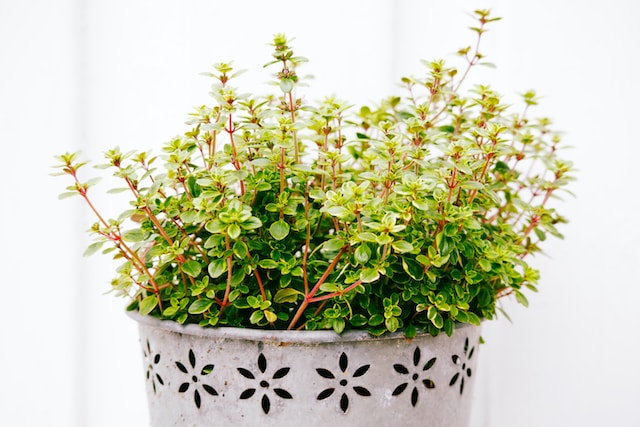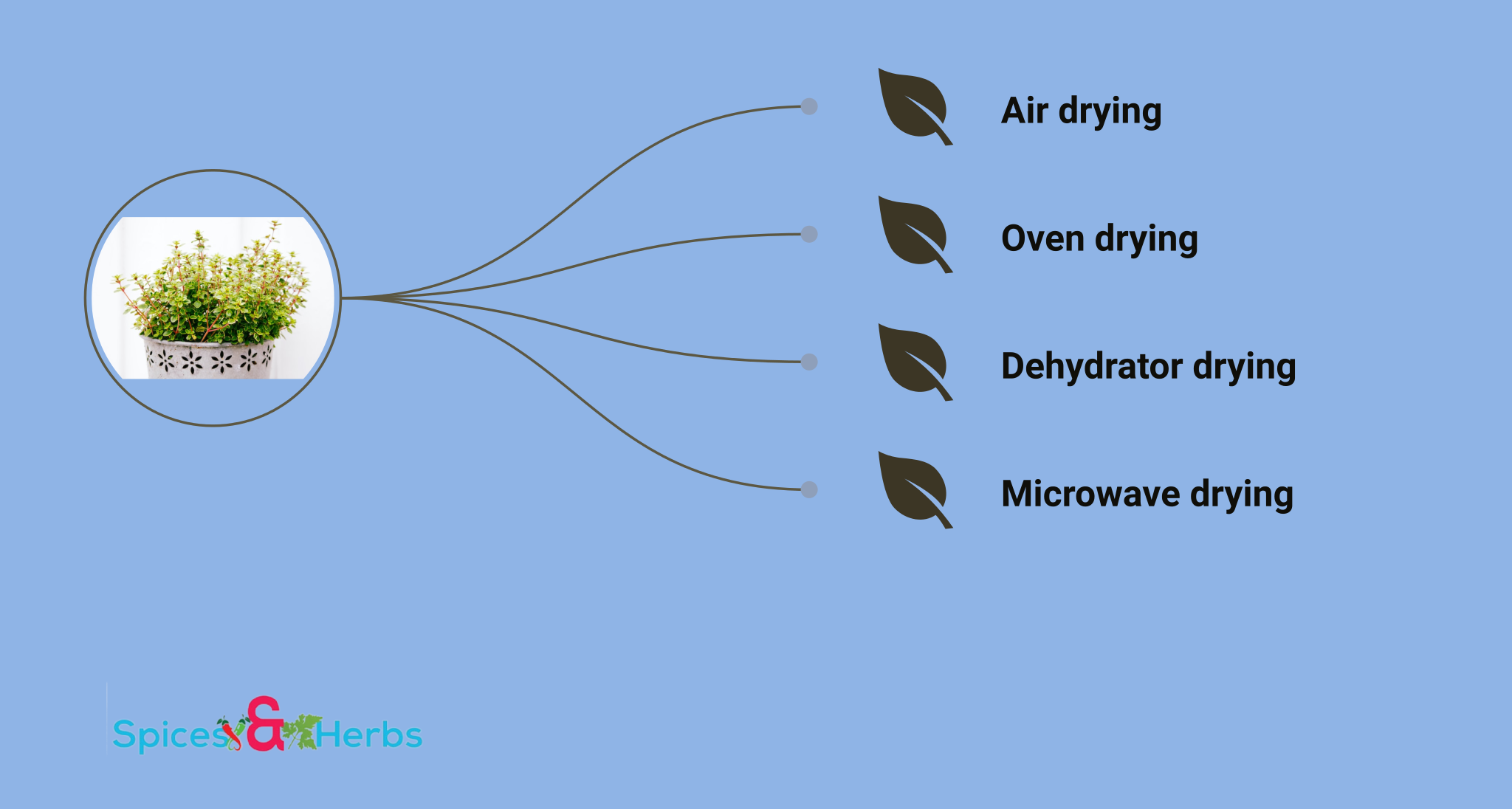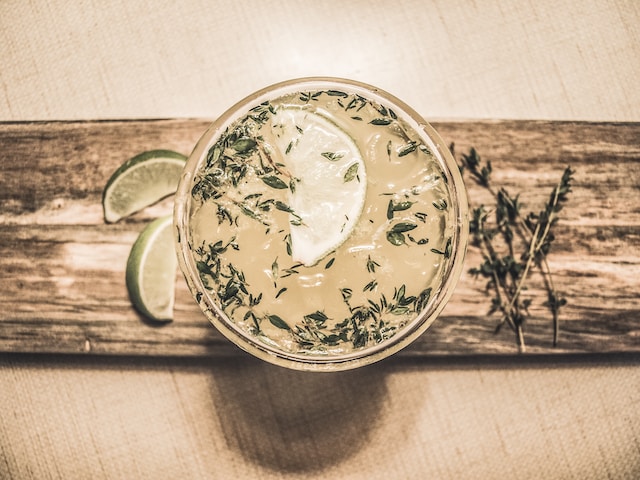Imagine capturing the essence of a sunny Mediterranean hillside and having it readily available in your kitchen. Thyme, with its delightful aroma and versatile flavor, is a culinary herb that can effortlessly elevate your dishes to new heights. However, thyme’s fresh leaves may not always be available, especially during the winter months or when you have an abundant harvest. Fear not, for there is a simple solution: drying and preserving thyme leaves. In this guide, we will explore easy methods to dry thyme, ensuring that you can enjoy its vibrant taste and captivating fragrance all year round. So, roll up your sleeves, and let’s reveal how to dry and preserve thyme!
Unique Characteristics of Thyme

Thyme is a popular herb popular for its aromatic properties and culinary uses. It also possesses several unique characteristics that set it apart from other herbs. Here are some of the notable features of thyme:
🟩 Aromatic leaves
Thyme leaves have a distinct and powerful fragrance, which is earthy, herbaceous, and slightly floral. The scent is due to the presence of essential oils, primarily thymol and carvacrol, which give thyme its characteristic aroma. When the leaves are crushed or rubbed, their fragrance intensifies, releasing a delightful scent that is instantly recognizable.
🟩 Evergreen perennial
Thyme is an evergreen plant, meaning it retains its leaves throughout the year, even in colder climates. This quality makes it an attractive herb for culinary and ornamental purposes, as it provides green foliage and fragrance even during the winter months. Thyme’s ability to maintain its leaves year-round makes it a reliable addition to any garden or herb collection.
🟩 Small, narrow leaves
Thyme leaves are small and narrow, typically measuring around half an inch to one inch in length. They are elliptical or lance-shaped and have a slightly fuzzy texture. The leaves grow densely on the plant’s stems, forming compact clusters. Their petite size and shape make them easy to handle and incorporate into recipes, and their fuzzy texture adds a pleasant tactile element when touched or crushed.
🟩 Woody stems
Thyme stems are woody and tend to be relatively thin and sturdy. They have a branching growth habit and can become somewhat rigid as the plant matures. The woody stems contribute to thyme’s durability and longevity, allowing the plant to withstand varying weather conditions and maintain its structure even under harsh circumstances.
🟩 Drought-tolerant
Thyme is known for its ability to thrive in dry conditions. It is highly drought-tolerant and can withstand periods of low water availability, making it suitable for growing in arid or Mediterranean climates. Its ability to conserve water is attributed to its small, leathery leaves and deep root system. Thyme’s remarkable resilience to drought makes it an ideal herb for gardeners in regions with limited rainfall or those who prefer low-maintenance plants.
🟩 Culinary versatility
Thyme is widely used as a culinary herb and is valued for its robust flavor. It is a staple ingredient in Mediterranean, French, and Italian cuisines, where it adds a distinct, earthy taste to dishes. Thyme pairs well with a variety of ingredients, including vegetables, meats, soups, stews, and marinades. Its versatility in the kitchen allows it to enhance the flavor profiles of numerous dishes, making it a go-to herb for many chefs and home cooks.
🟩 Medicinal properties
Thyme has a long history of medicinal use. It is believed to possess several health benefits, including antiseptic, antibacterial, antifungal, and antispasmodic properties. Thyme oil is sometimes used in natural remedies and aromatherapy due to its potential health-promoting effects. Thyme tea is known to soothe sore throats and coughs, and its essential oil is sometimes used in topical applications to aid in wound healing. Thyme’s medicinal properties have been recognized for centuries, and it continues to be valued for its potential therapeutic uses.
🟩 Insect-repellent properties
Thyme contains natural compounds that repel insects. The scent of thyme can deter pests like mosquitoes, flies, and moths, making it a useful addition to natural insect repellents or as a companion plant in gardens. Thyme’s insect-repellent properties make it an excellent choice for those who wish to minimize the use of chemical insecticides and create a more environmentally friendly garden environment.
🟩 Symbolic significance
Thyme has symbolic meaning in various cultures. It is associated with courage, strength, and purification. In ancient Greece, thyme was used as a symbol of bravery and was burned as incense during religious ceremonies. Additionally, thyme has been associated with remembrance and is often included in memorial gardens or used in rituals to honor loved ones who have passed away. The symbolic significance of thyme adds a layer of depth and meaning to its cultivation and use.
🟩 Ornamental value
Thyme’s attractive appearance and aromatic qualities make it a popular choice for ornamental gardens. It can be grown as a ground cover, creating a lush carpet of greenery that releases a pleasant fragrance when stepped on. Thyme’s delicate flowers, which bloom in shades of white, pink, or lavender, add a touch of beauty to garden beds and attract pollinators such as bees and butterflies. Its ornamental value makes thyme a versatile herb that can be grown for both practical and aesthetic purposes.
🟩 Easy to grow
Thyme is relatively easy to grow, making it suitable for gardeners of all skill levels. It can be grown from seeds or propagated through cuttings or division. Thyme thrives in well-draining soil and requires full sun exposure to develop its essential oils and flavorful leaves fully. Once established, it is a low-maintenance plant that requires minimal watering and pruning. Its adaptability and ease of cultivation make it a great choice for both experienced and novice gardeners.
🟩 Culinary and cultural history
Thyme has a rich culinary and cultural history spanning thousands of years. It has been used in traditional dishes across various cultures, including Mediterranean, Middle Eastern, and European cuisines. Ancient Egyptians used thyme in embalming practices, while the Romans associated it with courage and incorporated it into their baths and aromatic oils. Thyme’s historical significance adds depth and cultural connection to its usage in modern times, making it a herb that carries centuries of tradition and flavor.
🟩 Companion planting
Thyme is often used as a companion plant in gardens. It is believed to repel certain pests, such as cabbage worms, corn earworms, and tomato hornworms when it’s near susceptible crops. Additionally, thyme’s fragrant foliage can attract beneficial insects like bees and predatory wasps, which help with pollination and pest control in the garden. Its role as a companion plant demonstrates thyme’s ability to contribute to a healthier and more balanced garden ecosystem.
Ways to Dry and Preserve Thyme Leaves
Here are some common ways to dry and preserve thyme leaves:

🟥 Air Drying
There are several common methods to dry and preserve thyme leaves. One way is air drying. To do this, gather fresh thyme sprigs and tie them together with a string or rubber band. Hang the bundle upside down in a well-ventilated area, away from direct sunlight. Allow the thyme to air dry for about 1 to 2 weeks until the leaves become dry and brittle. Once dried, remove the leaves from the stems and store them in an airtight container.
🟥 Oven Drying
Another method is oven drying. Begin by preheating your oven to the lowest temperature setting, ideally around 100-120°C or 200-250°F. Strip the thyme leaves from the stems and spread them out in a single layer on a baking sheet. Place the baking sheet in the preheated oven, leaving the door slightly ajar to allow moisture to escape. Bake the thyme leaves for 1 to 2 hours until they are completely dry and crumbly. After they have cooled down, transfer them to an airtight container for storage.
🟥 Dehydrator Drying
Using a food dehydrator is another effective way to dry thyme leaves. Set up your dehydrator according to the manufacturer’s instructions. Strip the thyme leaves from the stems and arrange them in a single layer on the dehydrator trays. Set the dehydrator to a low temperature, typically between 35-45°C (95-113°F). Leave the thyme to dehydrate for about 1 to 3 hours until the leaves are thoroughly dried and brittle. Once cool, transfer the dried leaves to an airtight container.
🟥 Microwave Drying
Microwave drying is a quicker method. Strip the thyme leaves from the stems and spread them out on a microwave-safe plate lined with a paper towel. Microwave the thyme leaves on high power for short intervals, such as 30 seconds, and check their progress. Repeat the microwaving in short bursts until the leaves are dry and crumbly, taking care not to overheat or burn them. Allow the thyme leaves to cool before storing them in an airtight container.
Regardless of the drying method you choose, make sure the thyme leaves are completely dry before storing them. Store the dried thyme leaves in an airtight container, away from light and heat, to preserve their flavor and potency. Properly dried thyme leaves can last for several months to a year when stored correctly.
Difference of Fresh from Dried Thyme
Fresh thyme and dried thyme are both derived from the same herb, but there are some notable differences between the two in terms of flavor, aroma, and culinary usage. Here are the key distinctions:
🟦 Flavor and Aroma
- Fresh Thyme
Fresh thyme has a more vibrant and delicate flavor compared to its dried counterpart. The leaves of fresh thyme are tender and contain higher levels of moisture, which contributes to their subtle, slightly lemony taste with floral undertones. The fresh aroma of thyme is also more pronounced and adds a fragrant element to dishes.
- Dried Thyme
Dried thyme has a more concentrated flavor. During the drying process, the moisture is removed from the herb, intensifying its essential oils and flavors. Dried thyme tends to be stronger and more pungent, with a slightly earthy and woodsy taste. The dried leaves are also more brittle and have a crumbly texture.
🟦 Culinary Use
- Fresh Thyme
Fresh thyme is often used when a milder flavor and a touch of freshness are desired in dishes. It pairs well with a variety of foods and cuisines. Its versatile nature makes it suitable for enhancing the flavors of roasted meats, poultry, fish, vegetables, soups, and stews. Fresh thyme can be added to marinades or used as a garnish for an aromatic and visual appeal.
- Dried Thyme
Dried thyme is more commonly used in cooking due to its concentrated flavor. Its potency makes it ideal for long-cooked dishes, such as braises, stews, and slow-cooked sauces, where the flavors have time to meld together. Dried thyme also holds up well during baking and can be added to bread, biscuits, and savory pastries to infuse them with its distinct taste. Additionally, dried thyme is a key ingredient in spice blends, such as Herbes de Provence.
🟦 Conversion
As dried thyme is more potent than fresh thyme, you’ll need less dried thyme to achieve a similar flavor. When substituting dried thyme for fresh thyme in a recipe, a general rule of thumb is to use one-third of the amount. For example, if a recipe calls for 1 tablespoon of fresh thyme, you would use 1 teaspoon of dried thyme instead. It’s important to adjust the quantity accordingly to maintain the desired flavor balance in your dishes.
🟦 Availability and Storage
- Fresh Thyme
Fresh thyme is typically available in grocery stores, and farmers’ markets, and can also be grown in herb gardens. When purchasing fresh thyme, look for vibrant green leaves without any signs of wilting or browning. Fresh thyme has a limited shelf life and should be used within a week or two for optimal flavor. To store fresh thyme, wrap the stems loosely in a damp paper towel and place them in a plastic bag. Store the bag in the refrigerator’s vegetable drawer to keep the herb fresh.
- Dried Thyme
Dried thyme is widely available in spice sections or stores, making it a convenient pantry staple. Look for good-quality dried thyme that is fragrant and retains its green color. Dried thyme has a longer shelf life compared to fresh thyme and you can store it for several months. To maintain its flavor and potency, store dried thyme in a cool, dark place in an airtight container. Avoid exposing it to heat, moisture, or sunlight, as these can degrade the herb’s quality.
Culinary Uses of Dried and Preserved Thyme Leaves

Dried and preserved thyme leaves are versatile culinary ingredients that can enhance the flavor of various dishes. Here are some common culinary uses of dried and preserved thyme leaves:
🟨 Pasta sauces
Add dried thyme leaves to tomato-based pasta sauces for an extra layer of flavor. They complement the acidity of the tomatoes and provide a pleasant herbal note. Thyme goes particularly well with classic Italian sauces like marinara and Bolognese.
🟨 Herb-infused salts
Create custom herb-infused salts by combining dried thyme leaves with other herbs and spices. Experiment with different combinations to suit your taste preferences. These flavored salts can be used as a finishing touch for roasted vegetables, or grilled meats, or sprinkled over popcorn for a gourmet twist.
🟨 Herb-infused butter
Blend dried thyme leaves into softened butter along with other herbs and spices to create a delicious compound butter. This herb-infused butter can be used to top steaks, melt over grilled vegetables, or spread on bread. It’s a simple way to elevate the flavors of your dishes.
🟨 Stuffing
Dried thyme leaves are a fantastic addition to stuffing recipes. Whether you’re preparing a traditional holiday stuffing or a stuffing for roasted poultry, the earthy and aromatic flavor of thyme enhances the overall taste. Combine dried thyme leaves with breadcrumbs, onions, celery, and other herbs for a flavorful stuffing.
🟨 Quiches and frittatas
Incorporate dried thyme leaves into quiches and frittatas to add a savory note to the egg-based dishes. The herb pairs well with various fillings such as cheese, mushrooms, spinach, and ham. It imparts a delightful aroma and enhances the overall taste of the dish.
🟨 Gravies and sauces
When making gravies and sauces, dried thyme leaves can contribute depth and complexity to the flavors. Whether you’re preparing a rich beef gravy or a savory mushroom sauce, the addition of thyme can take the sauce to a new level. Simmer the dried thyme leaves in the sauce to allow the flavors to meld together.
🟨 Herb-infused oils and vinegar
Dried thyme leaves can be used to make infused oils and vinegar, which are great for adding flavor to dressings, marinades, and dips. Place the leaves in a bottle with olive oil or vinegar, seal it, and let it sit for a few weeks to infuse the flavors. The resulting infused oil or vinegar can be drizzled over salads, roasted vegetables, or used as a marinade for meats.
🟨 Herb rubs and blends
Combine dried thyme leaves with other herbs and spices to create homemade herb rubs or blends. These can be used to season meats, poultry, or fish before grilling, roasting, or pan-searing. Create your own signature blend by experimenting with different herbs and spices to suit your taste preferences.
🟨 Salad dressings
Add dried thyme leaves to homemade salad dressings to impart a subtle herbal note. Thyme pairs well with lemon vinaigrettes, balsamic dressings, and creamy herb dressings. The herb adds depth to the dressings and can elevate the flavors of your salads.
🟨 Infused syrups
You can use dried thyme leaves to infuse simple syrups. Then, you can use the syrup in cocktails, mocktails, or to sweeten beverages like iced tea or lemonade. The herb adds a unique twist to the sweet syrup, creating a refreshing and aromatic drink.
🟨 Herb-infused honey
Combine dried thyme leaves with honey for a flavorful herb-infused sweetener. The herbaceous taste of thyme adds an interesting dimension to the honey. Use it to drizzle over yogurt, pancakes, or as a sweetener for herbal teas.
🟨 Homemade herb blends
Create your own custom herb blends by combining dried thyme leaves with other herbs and spices. Experiment with different combinations to suit your taste preferences. These herb blends can be used in a variety of dishes, such as roasted vegetables, grilled meats, or sprinkled over pizzas.
🟨 Bean dishes
Dried thyme leaves work well in bean-based dishes like chili, lentil soups, or bean stews. They add a savory and aromatic flavor that complements the earthiness of the beans. Thyme can be used in both vegetarian and meat-based bean recipes to enhance the overall taste.
By drying and preserving thyme leaves, your culinary expedition is endless!
Final Words
As we conclude this blog post on dry and preserve thyme, we hope that you have found the information and tips provided to be both useful and inspiring. Thyme is a versatile herb that adds incredible flavor and aroma to a wide range of dishes, and by learning how to dry and preserve it, you can enjoy its benefits all year round.
Preserving thyme not only ensures that you have a fresh supply of this herb at your fingertips whenever you need it but also allows you to savor its delightful essence even during the off-season. Whether you choose to air-dry, oven-dry, or use a dehydrator, the key is to handle the thyme with care, preserving its essential oils and maintaining its distinct flavor profile.
By following the recommendations in this blog, you can successfully dry your thyme and store it for future culinary adventures. From seasoning meats and vegetables to infusing oils and creating homemade herbal teas, the possibilities with dried thyme are endless. Plus, the satisfaction of incorporating your homegrown or hand-picked thyme into your recipes is truly rewarding! Happy cooking!
